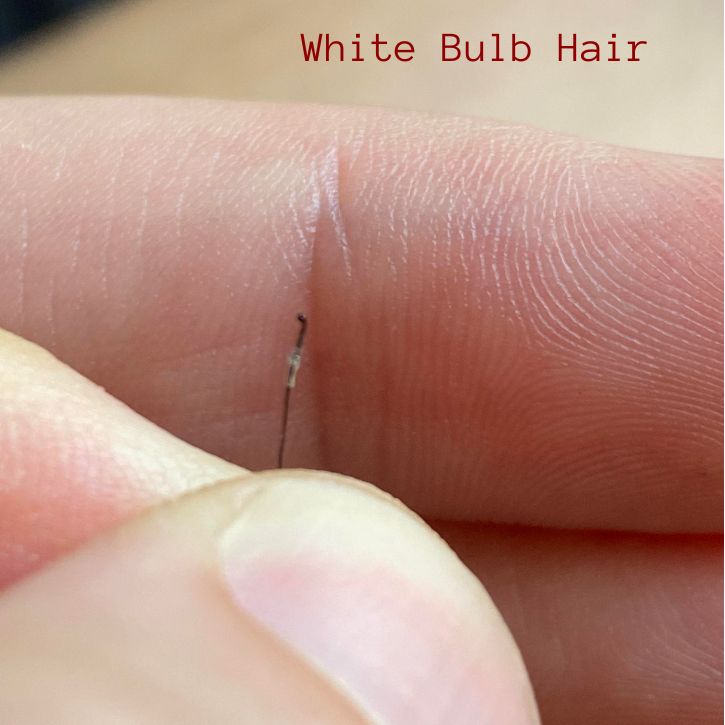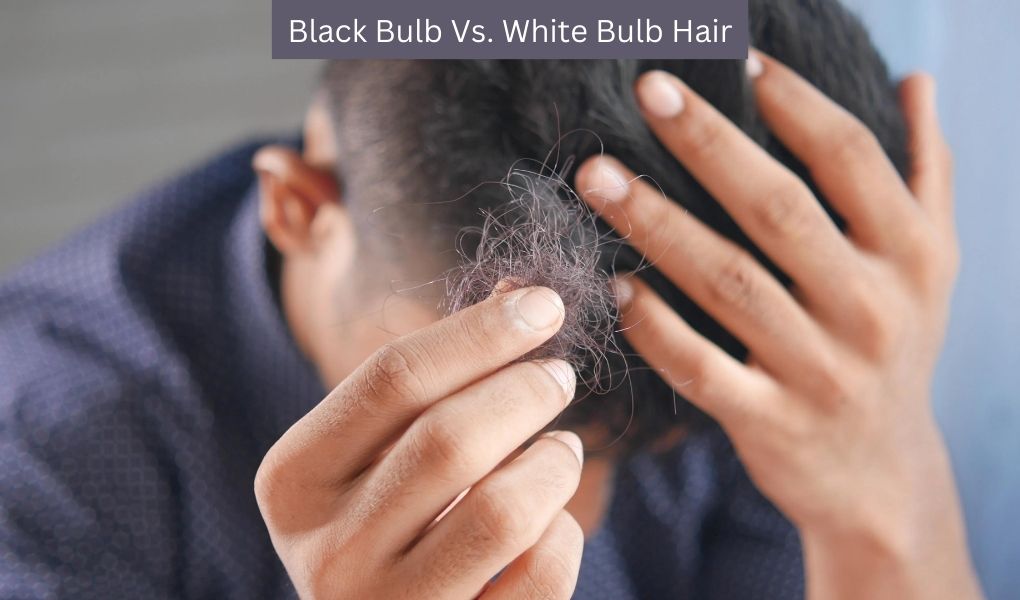Hair shedding is a normal part of everyone’s life; on average, a person may lose 50 to 100 hairs daily. When hair sheds, the hair bulb, situated at the hair strand’s end inside the scalp, might show. Fascinatingly, the hair bulb’s color—be it black or white, reveals a lot about hair loss nature and condition.
Quick Summary
- Black Bulb Hair: Usually seen when you pull hair out. This hair is in the catagen or transition phase of the hair growth cycle.
- White Bulb Hair: Results from natural shedding or conditions like androgen alopecia. These hairs are in the telogen or resting phase.
Keep reading to delve deeper into the differences and find out how to promote hair growth and stop hair loss.
Understanding Hair: Anatomy and Growth Cycle
Anatomy of Hair
Firstly, it’s essential to distinguish between the hair bulb and the hair club. The white stuff at the end of fallen hair isn’t the hair root; it’s the hair club. Hair encompasses the hair shaft, hair follicle, sebaceous gland, and arrector pili muscle.
The hair root/bulb, the living part of hair, produces keratin and melanin, contributing to hair growth and color.
The hair club, connecting the shaft to the root, is a dead part, so spotting it means new hair will still emerge.
Hair Growth Cycle
The hair growth cycle governs the growth, shedding, and regrowth of hair, consisting of:
- Anagen Phase: The active growth stage where hair cells divide rapidly, lasting several years.
- Catagen Phase: A transitional stage where growth slows, and the follicle shrinks, lasting a few weeks.
- Telogen Phase: The resting stage where the follicle is inactive, lasting several weeks to months.
- Exogen Phase: Old hair sheds, making way for new growth.
The cycle then repeats, with the new hair entering the anagen phase. Cycle length and phase duration vary, influenced by genetics, age, and health.
Exploring Black Bulb Hair
Black bulb hair, with its distinctive dark bulb, is usually in the catagen phase.
It emerges predominantly when pulled out forcefully, but some conditions like post-chemotherapy and anagen effluvium can also cause it. Despite its look, the black sheath isn’t the hair follicle, ensuring hair will regrow.

Unveiling White Bulb Hair
In contrast, white bulb hair indicates the telogen phase, shedding naturally as the root stops producing melanin and keratin.
Causes include natural telogenic hair loss and androgenic alopecia. Notably, there are differences in thickness between naturally shed hair and that lost due to androgenic alopecia.
Black Bulb Vs White Bulb: The Contrast
The primary distinction lies in the bulb color and the hair’s phase in the growth cycle.
Black bulb signifies forcibly removed hair in the catagen phase, whereas white bulb marks natural or condition-induced shedding in the telogen phase.
Do Miniaturized Hairs Have White Bulb?
Yes, miniaturized hairs, which result from shrinking follicles due to genetic or hormonal factors, can have a white bulb. This phenomenon is especially seen in androgenic alopecia.
Halting Hair Loss: A Comprehensive Guide
Hair loss might worry many, but several strategies can support hair health and slow down the process:
- Balanced Diet: Ensure your diet is rich in essential nutrients like protein, iron, vitamins, and omega-3 fatty acids.
- Avoid Damaging Styling: Limit heat tools, chemical treatments, and harsh colors.
- Stay Hydrated: Drink plenty of water for overall health.
- Exercise Regularly: Keep active to balance hormones and boost circulation.
- Gentle Hair Care: Use a wide-toothed comb, avoid pulling, and opt for loose hairstyles.
- Manage Stress: Practice stress-reducing activities like meditation and yoga.
- Limit Sun Exposure: Protect your hair with hats or scarves outdoors.
- Scalp Massages: Stimulate blood circulation with regular massages using essential oils.
- Consult a Professional: For significant hair loss, seek advice from dermatologists or trichologists.
- Health Check-ups: Regularly screen for underlying health issues affecting hair loss.
- Seek Professional Guidance: If you notice excessive hair loss or have concerns about its causes, consult a dermatologist or trichologist. These specialists can diagnose any underlying conditions and recommend appropriate treatment options. Studies highlight the importance of professional assessment in addressing hair loss (Price, 1999).
Maintaining a balanced lifestyle and consulting professionals when necessary are key to optimal hair health.
Conclusion
Deciphering the difference between black bulb hair and white bulb hair enlightens us about our hair’s growth cycle and potential concerns regarding hair loss.
If you encounter excessive hair loss or noticeable changes in hair texture or thickness, consulting a dermatologist is crucial. Remember, incorporating a healthy diet, regular exercise, and suitable hair supplements are beneficial for maintaining vibrant hair.
Frequently Asked Questions (FAQs)
1. What does the color of the hair bulb indicate?
The color of the hair bulb—either black or white—reveals information about the nature and condition of hair loss. A black bulb is typically seen in the catagen phase, while a white bulb indicates the hair is in the telogen phase.
2. What is the main difference between black bulb hair and white bulb hair?
Black bulb hair is usually in the catagen or transitional phase and often results from hair being pulled out, while white bulb hair is in the telogen or resting phase, shedding naturally or due to conditions like androgen alopecia.
3. Is the black sheath in black bulb hair the hair follicle?
No, the black sheath is not the hair follicle. Despite its appearance, hair will still regrow as the follicle remains intact.
4. Can miniaturized hairs have a white bulb?
Yes, miniaturized hairs, which are often associated with conditions like androgenic alopecia, can have a white bulb.
5. What are some strategies to prevent hair loss?
To prevent hair loss, maintain a balanced diet rich in essential nutrients, avoid damaging hair styling, stay hydrated, exercise regularly, practice gentle hair care, manage stress, limit sun exposure, perform scalp massages, and consult a professional for significant hair loss.
6. What is the significance of spotting a hair club in fallen hair?
Spotting a hair club, which is the white part at the end of fallen hair, indicates that it is not the hair root. This means that new hair will still emerge as the living part of the hair (the bulb) is still intact.
7. How does the hair growth cycle affect hair loss?
The hair growth cycle, consisting of the anagen, catagen, telogen, and exogen phases, governs the growth, shedding, and regrowth of hair.
The length of the cycle and the duration of each phase, influenced by genetics, age, and health, affect the rate and nature of hair loss.
8. Should I consult a professional if I notice changes in hair thickness or texture?
Yes, consulting a dermatologist or a trichologist is crucial if you encounter excessive hair loss or noticeable changes in hair texture or thickness.
9. Does the hair bulb color give insight into specific hair conditions?
Yes, the color of the hair bulb can provide insight into whether the hair loss is natural, due to forceful removal, or associated with specific conditions like androgenic alopecia.
10. How can I promote overall hair health?
Maintaining a balanced lifestyle, incorporating a healthy diet, exercising regularly, using suitable hair care products, and consulting professionals when necessary are essential for promoting overall hair health.
Reference
Price, V. H. (1999). Treatment of hair loss. New England Journal of Medicine, 341(13), 964-973. https://www.nejm.org/doi/full/10.1056/NEJM199909233411307

